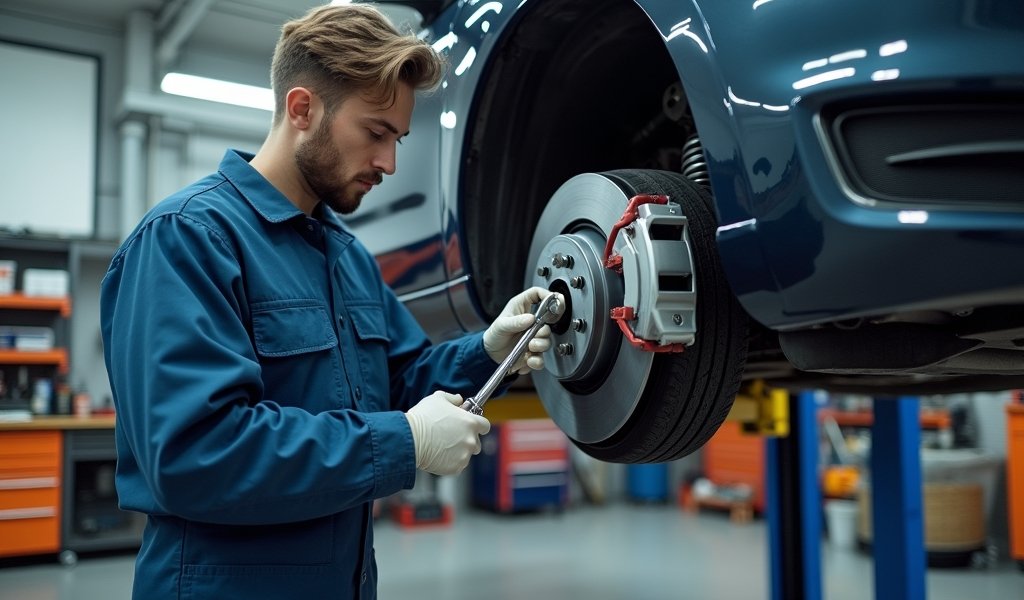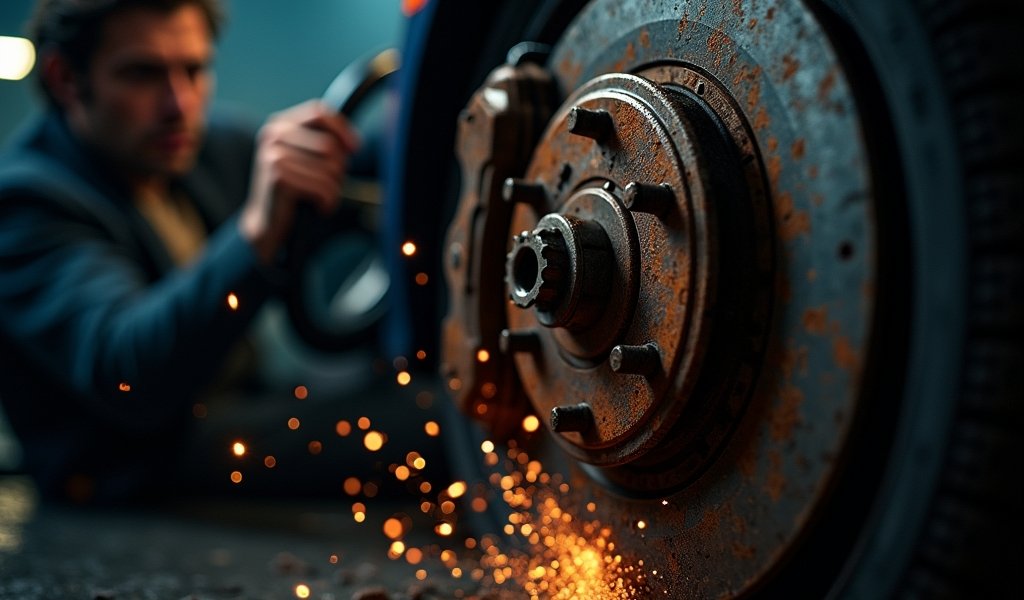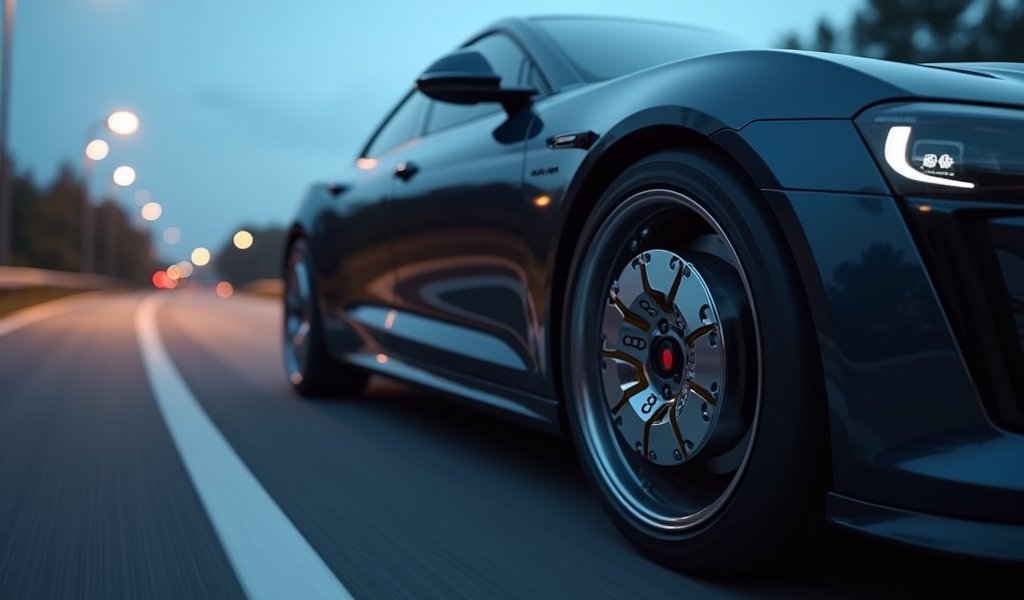Overview
This article identifies seven common causes of squeaky brakes—including worn pads, glazed rotors, contamination, low-quality components, improper installation, weather issues, and lack of lubrication—while providing specific DIY fixes and maintenance tips for each problem. The expert mechanic emphasizes that while most brake squeaks aren’t immediately dangerous, they serve as important warning signals that shouldn’t be ignored, and certain symptoms like grinding sounds or reduced braking power require immediate professional attention.
Table of Contents
- Understanding Why Brakes Squeak
- Cause #1: Worn Brake Pads
- Cause #2: Glazed Brake Rotors
- Cause #3: Brake Dust and Debris
- Cause #4: Low-Quality Brake Components
- Cause #5: Improper Installation
- Cause #6: Weather-Related Issues
- Cause #7: Lack of Lubrication
- Preventative Maintenance for Quiet Brakes
- When to Seek Professional Help
- Conclusion
- Frequently Asked Questions
That high-pitched squeal when you tap your brakes isn’t just annoying – it’s your vehicle’s way of waving a red flag. As a mechanic with 15+ years in the shop, I’ve seen countless drivers wince at squeaky brakes. The good news? Most brake squeaks aren’t catastrophic, but understanding what causes them can save you money and keep you safer on the road.
Let’s face it – nobody wants their arrival announced by a symphony of brake squeals. Whether you’re pulling up to work or easing into your driveway after a late night, those noises can be downright embarrassing (not to mention concerning).
In this guide, I’ll walk you through the seven most common causes of squeaky brakes and share the proven fixes I’ve used throughout my career. No technical jargon, just straight talk from someone who’s silenced thousands of squeaky brakes over the years.
Understanding Why Brakes Squeak
Think of brake noise like a conversation your car is trying to have with you. Those squeaks and squeals are vibrations – tiny energy waves created when something isn’t quite right in your braking system.
When you press your brake pedal, you’re activating a sophisticated friction system. Your calipers squeeze the brake pads against the rotors, creating the friction needed to slow your vehicle. Any irregularity in this process – whether from wear patterns, contamination, or improper installation – can create vibrations that reach your ears as that dreaded squeak.
Here’s something many drivers don’t realize: even brand-new brakes can squeak under certain conditions. The key is determining whether that noise is just an annoyance or a genuine safety concern that needs immediate attention.

Cause #1: Worn Brake Pads
This is probably what you first suspected, and for good reason. Worn brake pads are among the most common causes of brake noise, especially that high-pitched squeal that seems to get louder over time.
Most modern brake pads are designed with built-in wear indicators – small metal tabs that contact your rotors when pad material gets dangerously thin. That contact creates the squeal, essentially giving you an audible warning before metal-on-metal damage occurs.
When I check a customer’s brakes, I’m looking for at least 3-4mm of friction material. Anything less than that and you’re in the danger zone, especially if you do a lot of stop-and-go driving or frequent highway travel.
The Fix:
Replace your brake pads before they wear down completely. This typically costs between $150-300 per axle, depending on your vehicle and the quality of pads you choose. The job takes 1-2 hours at most repair shops, and many experienced DIYers can handle it at home with basic tools.
Pro tip: When replacing pads, always check your rotors too. Even the best pads won’t perform well or quietly on damaged rotors. According to NHTSA safety guidelines, both components work as a system and should be evaluated together.
Cause #2: Glazed Brake Rotors
Ever notice a shiny, bluish discoloration on your brake rotors? That’s glazing, and it’s a common cause of squeaky brakes, especially after periods of aggressive driving or long downhill descents.
Glazing happens when rotors get excessively hot and the surface material actually changes composition. This creates a hardened, smooth surface that doesn’t provide the proper friction coefficient for your brake pads. The result? Poor stopping power and that distinctive squeaking as the pad tries to grip the too-smooth surface.
The Fix:
Depending on the severity of glazing and the thickness of your rotors, you have two options:
- Resurfacing (turning): This machine process removes a thin layer of rotor material to create a fresh braking surface. Costs about $15-30 per rotor at most shops.
- Replacement: If rotors are too thin for resurfacing or severely warped, complete replacement is necessary ($50-125 per rotor plus labor).
To prevent future glazing, avoid riding your brakes, especially on long downhill stretches. Instead, use engine braking by downshifting and apply brakes intermittently to allow cooling between applications.
Cause #3: Brake Dust and Debris
Your brakes operate in a harsh environment – constantly exposed to road grime, water, dirt, and their own brake dust. This accumulation of contaminants can cause intermittent squeaking that might temporarily disappear after driving through water (which briefly washes the assembly).
Brake dust is particularly problematic because it contains abrasive particles from both the pad and rotor material. When this dust builds up between components, it can create that annoying squeak and potentially accelerate wear if left unchecked.
The Fix:
A thorough brake cleaning can often solve this issue without replacing parts. For the DIY approach:
- Purchase quality brake cleaner spray ($5-10 per can)
- Safely elevate and secure your vehicle
- Remove wheels for better access
- Spray brake components thoroughly, focusing on areas where the pad contacts the caliper
- Use a firm brush for stubborn deposits
- Allow components to dry completely before reassembly
Always wear eye protection and gloves during this process, and never use petroleum-based products on brake components as they can damage rubber parts and reduce braking efficiency.
This simple maintenance can be performed during routine DIY maintenance like tire rotations, potentially saving you hundreds in unnecessary parts replacements.
Cause #4: Low-Quality Brake Components
I’ve seen this scenario countless times: a customer comes in complaining about noisy brakes shortly after having them replaced at a budget shop. The culprit? Economy brake pads with hard, noisy compounds.
Brake pad formulations vary dramatically, with cheaper options typically containing harder compounds that create more noise. While these budget parts might save money initially, they often lead to customer dissatisfaction and premature wear of other brake components.
The Fix:
Investing in premium, ceramic brake pads (typically $30-60 more per axle than economy options) usually results in quieter, more effective braking. These higher-quality pads often include better shims and damping features specifically designed to reduce noise.
While the initial cost is higher, premium components generally last longer and perform better, making them more cost-effective over time. They’re also much kinder to your rotors, which are typically more expensive to replace than pads.
Research from Consumer Reports shows that premium brake components can last up to 30% longer than budget alternatives, making them a better value despite the higher initial cost.

Cause #5: Improper Installation
Even the best brake components will squeal if they’re not installed correctly. In my shop, I’ve fixed countless noisy brakes that were recently serviced elsewhere but improperly installed.
Common installation issues include:
- Missing or improperly installed anti-rattle clips
- Incorrect application of brake lubricant (or wrong type used)
- Improper torque on caliper bolts
- Failure to clean mating surfaces properly
- Pads installed backward (yes, this happens!)
The Fix:
If you’ve recently had brake work done and immediately experience squeaking, return to your service provider for inspection and adjustment. Any reputable shop should address this under warranty.
For the DIYers among you, follow manufacturer instructions precisely and consider using a torque wrench for proper bolt tightening. Pay special attention to the proper application of brake lubricant – it belongs on the back of the pads and contact points with the caliper, never on friction surfaces.
Taking photos before disassembly can help ensure everything goes back exactly as it should. This simple step has saved me countless headaches during complex brake jobs.
Cause #6: Weather-Related Issues
Ever notice your brakes squeak more on dewy mornings or after rain? You’re not imagining things. Moisture and extreme temperatures can temporarily affect brake performance in ways that cause noise but don’t necessarily indicate a problem.
Overnight moisture can create a thin layer of surface rust on rotors – perfectly normal and typically gone after a few brake applications. In extremely cold conditions, different contraction rates between metal components can temporarily create gaps that cause noise until the system warms up.
The Fix:
For normal weather-related squeaking that disappears after driving, no action is typically needed. The noise should resolve once components return to normal operating temperature and moisture evaporates.
However, in persistently wet climates or for vehicles stored outdoors, more frequent brake maintenance may be necessary to prevent corrosion. Consider these additional steps:
- Apply a thin coat of high-temperature brake grease to non-friction metal parts
- Schedule more frequent brake inspections during rainy seasons
- If possible, store your vehicle in a dry environment
- Perform regular short drives in stored vehicles to prevent rust formation
Cause #7: Lack of Lubrication
Your brake system contains several metal-on-metal contact points that require proper lubrication to function quietly. When these points dry out or become contaminated, the result is often a distinctive squeak or groan, particularly when applying or releasing the brakes.
The most common areas needing lubrication include the caliper slide pins, the backs of brake pads, and the points where pads contact the caliper bracket. When these go dry, components can bind, causing uneven pad wear and noise.
The Fix:
Apply high-temperature brake lubricant ($5-15) to all metal-on-metal contact points. This specialized lubricant is designed to withstand extreme temperatures without breaking down.
Important: Never apply lubricant to the friction surface of pads or rotors! This seems obvious, but it’s a mistake I’ve seen DIYers make. Lubricant belongs only on the back of pads, caliper slide pins, and where pads contact the bracket.
Over-lubrication can be just as problematic as under-lubrication if it contaminates friction surfaces. Apply sparingly and precisely, wiping away any excess before reassembling components.
Preventative Maintenance for Quiet Brakes
As with most automotive issues, prevention beats cure when it comes to squeaky brakes. Here are the practices I recommend to my customers for maintaining quiet, effective brakes:
- Listen for changes in brake sounds during regular driving – early intervention saves money
- Inspect brake components during seasonal tire changes
- Clean brake assemblies when performing routine maintenance
- Schedule annual brake inspections even if no problems are apparent
- Use quality parts when replacements are needed
- Break in new brakes properly according to manufacturer recommendations
- Consider your driving habits – aggressive braking generates more heat and wear
Building these simple habits into your regular vehicle inspection routine can prevent most brake noise issues before they start, saving you money and frustration.
When to Seek Professional Help
While many brake issues can be addressed with DIY maintenance, certain symptoms demand immediate professional attention. In my decades as a mechanic, I’ve seen too many people ignore warning signs until they turned into expensive (or dangerous) problems.
Contact a qualified brake specialist immediately if you experience:
- Grinding metal-on-metal sounds (indicates pads are completely worn)
- Brake pedal that feels soft or sinks to the floor (possible hydraulic issues)
- Vehicle pulling to one side during braking (caliper or alignment problems)
- Vibration or pulsation when braking (warped rotors or hub issues)
- Warning lights on your dashboard
- Any reduction in braking effectiveness
These symptoms often indicate problems beyond simple noise concerns and could affect your ability to stop safely. No amount of saved money is worth compromising safety when it comes to your braking system.
Conclusion
Those squeaky brakes might be annoying, but they’re also giving you valuable information about your vehicle’s condition. By understanding these seven common causes and their fixes, you’re now equipped to address minor issues before they become major problems.
Remember that brake maintenance isn’t just about silencing noise—it’s about ensuring your vehicle can stop safely and reliably every time you press that pedal. Regular inspection and maintenance are investments in both comfort and safety.
Whether you tackle these fixes yourself or seek professional help, addressing brake issues promptly will save you money in the long run by preventing more extensive damage to other components. Your wallet (and your ears) will thank you.
Next time you hear that telltale squeak, you’ll know exactly what your car is trying to tell you—and more importantly, what to do about it.
Frequently Asked Questions
Is it safe to drive with squeaky brakes?
It depends on the cause of the squeak. Light squeaking from weather conditions or dust is typically safe, but grinding noises or reduced braking power require immediate attention.
How much does it cost to fix squeaky brakes?
Costs range from $5 for DIY brake cleaning to $300+ per axle for complete brake service. The exact price depends on your vehicle and the underlying cause.
Can I just spray WD-40 on my brakes to stop squeaking?
Never use WD-40 or other petroleum-based products on brakes. These can contaminate friction surfaces and severely reduce braking effectiveness, creating a safety hazard.
How long should brake pads last before they start squeaking?
Quality brake pads typically last 30,000-70,000 miles depending on driving conditions and habits. Premature squeaking may indicate low-quality pads or other issues needing attention.
Will new brakes always squeak at first?
Some new brakes may have a break-in period with minor noise, typically resolving after 100-200 miles of driving. Persistent squeaking in new brakes usually indicates installation issues or low-quality components.

